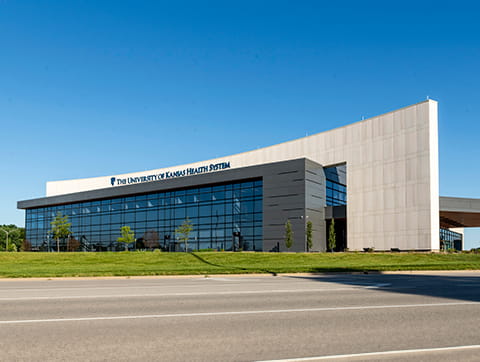Rheumatology

The rheumatologists at The University of Kansas Health System are experts in autoimmune, inflammatory and noninflammatory adult rheumatologic disorders of the joints and muscles. We offer comprehensive, state-of-the-art diagnosis and management of common and complex rheumatological conditions.
About rheumatology
Rheumatology is a field of study that includes the joints, soft tissues, autoimmune diseases and heritable connective tissue disorders. A rheumatologist is a doctor who specializes in diagnosing and treating rheumatic diseases.
The rheumatologists at The University of Kansas Health System are physicians and faculty members at the University of Kansas School of Medicine, teaching medical students, residents and other healthcare professionals innovative approaches to diagnosing and treating diseases of the joints and muscles.
We offer a variety of appointment types. Learn more or call 913-588-1227 to schedule now.
Rheumatology services
As part of an academic medical center, our rheumatology specialists provide unique and advanced diagnostic studies and treatment options, along with resources and clinical trials that may not be available elsewhere. The rheumatological conditions treated include:
Bursitis happens when the bursae, which are small fluid-filled sacs that cushion the joints, become inflamed. Joints may feel painful, achy or stiff and can become swollen or red. Treatment is often rest but can also involve medication, physical therapy, corticosteroid injections or surgery.
Connective tissue disease is an umbrella term that encompasses many different connective tissue disorders. They include lupus, myositis, scleroderma and rheumatoid arthritis.
Symptoms of dermatomyositis are a red or violet-colored rash that is itchy and painful along with progressive muscle weakness on both sides of the body. Dermatomyositis is uncommon and can be treated with medication.
Both gout and pseudogout are inflammatory forms of arthritis. Their symptoms are very similar, but treatment will differ depending on which is present. It requires analysis under a microscope to diagnose gout versus pseudogout. Both are characterized by red, hot, swollen and painful joints.
Systemic lupus erythematosus (SLE) is the most common type of lupus. Common symptoms are skin rashes, arthritis, swelling in the feet or around the eyes, headaches, extreme fatigue, blood clots and low fevers. Lupus is a chronic condition that can be managed with medications.
Lyme disease is caused by bacteria that is often transmitted to humans through a tick bite. Lyme disease progresses through several stages. Initial symptoms are a rash around the tick bite, fever, headache, joint stiffness, fatigue, muscle pain and swollen lymph nodes. In the early stage, antibiotics are used to treat lyme disease.
Myositis generally refers to immune diseases causing chronic inflammation of the muscles. Your muscles will feel weak and potentially painful. It can also cause fatigue and difficulty swallowing. Medications and physical therapy can help manage symptoms.
This is the most common form of arthritis, and it can affect any joint in the body. Symptoms include joint pain, stiffness and tenderness, loss of flexibility, bone spurs and swelling. Age, weight and genetics are all risk factors for developing osteoarthritis. It can be managed with medications, physical therapy, nerve stimulation, injections and even joint replacement.
Widespread aching and stiffness of the muscles and joints is a hallmark of polymyalgia rheumatica. It can also cause mild fever, fatigue, loss of appetite and depression. Medications and physical therapy may be prescribed along with lifestyle changes such as eating a healthy diet, exercising and resting enough.
Psoriatic arthritis is a type of arthritis that often occurs in people with a personal or familial history of psoriasis. Similar to other forms of arthritis, it causes joint pain, stiffness and swelling. However, it also features psoriasis rashes and discoloration or pitting of the fingernails. Medications, physical therapy and occupational therapy are often recommended. In rare cases joint replacement surgery may be advised.
Rheumatism is a general term to refer to rheumatic diseases. Those may include rheumatoid arthritis, lupus, gout, scleroderma, juvenile idiopathic arthritis, Sjögren’s syndrome and polymyalgia rheumatica.
Rheumatoid arthritis (RA) is an autoimmune disease that causes painful joint inflammation, swelling and reduced range of motion. There are several different forms of RA. The primary treatment for RA is taking immunosuppressants. Physical or occupational therapy may also be recommended.
A group of autoimmune diseases causing hardening and tightening of the skin are called scleroderma or systemic sclerosis. In addition to causing swelling, itchiness and color changes of the skin, some types of scleroderma can affect the digestive system, heart, lungs and kidneys. Treatments for scleroderma will differ depending on which parts of the body are affected.
Sjogren’s syndrome damages glands throughout the body that produce moisture. This includes tear ducts, mouth, nose, throat, digestive system and vagina. In addition to dryness at those sites, Sjogren’s syndrome can also cause joint and muscle pain, fatigue, rashes, heartburn, brain fog and more. Sjogren’s can be triggered by viral illnesses like Epstein-Barr and COVID-19. Autoimmune diseases can also trigger Sjogren’s. It can be treated with products to restore moisture to the affected areas, in addition to pain relievers, corticosteroids or immunosuppressants.
Spondyloarthropathies are forms of arthritis that frequently affect the spine or other joints close to the spine. Back pain is the most common symptom, but other forms of joint pain, swelling and pain can be present. It can be treated with medications and physical therapy. In some circumstances joint replacement might be recommended.
Muscles are attached to bone by tendons. These fibrous cords can become inflamed, causing pain near a joint. This inflammation is called tendonitis. Common types include Achilles tendinitis, golfer’s elbow, patellar tendinitis and tennis elbow. Most tendinitis is treated with rest, pain relievers and physical therapy. More advanced treatments include steroids, injections, dry needling and surgical repair.
Vasculitis is an inflammation of the blood vessels that causes them to narrow and can lead to organ and tissue damage. The type of vasculitis is determined by the size of the blood vessels that are affected. Symptoms of vasculitis include fatigue, fever, generalized pain, headache and weight loss. The most common treatment for vasculitis is an oral corticosteroid. In some cases, surgery may be needed.

Expert care for rheumatoid arthritis
The University of Kansas Health System offers comprehensive care for rheumatoid arthritis. In addition to rheumatologists, our collaborative care team includes specialists who can treat joint problems as well as specialists who can address related conditions in other parts of the body.
Current patients can self-schedule care through MyChart. Don’t have a MyChart account? Sign up now to create one.

Find a doctor
Doctors at The University of Kansas Health System are care providers and researchers at the forefront of new medical discoveries. From primary care to complex conditions, we offer hundreds of specialists.
Note: The South Kansas City Medical Pavilion offers infusion services.




